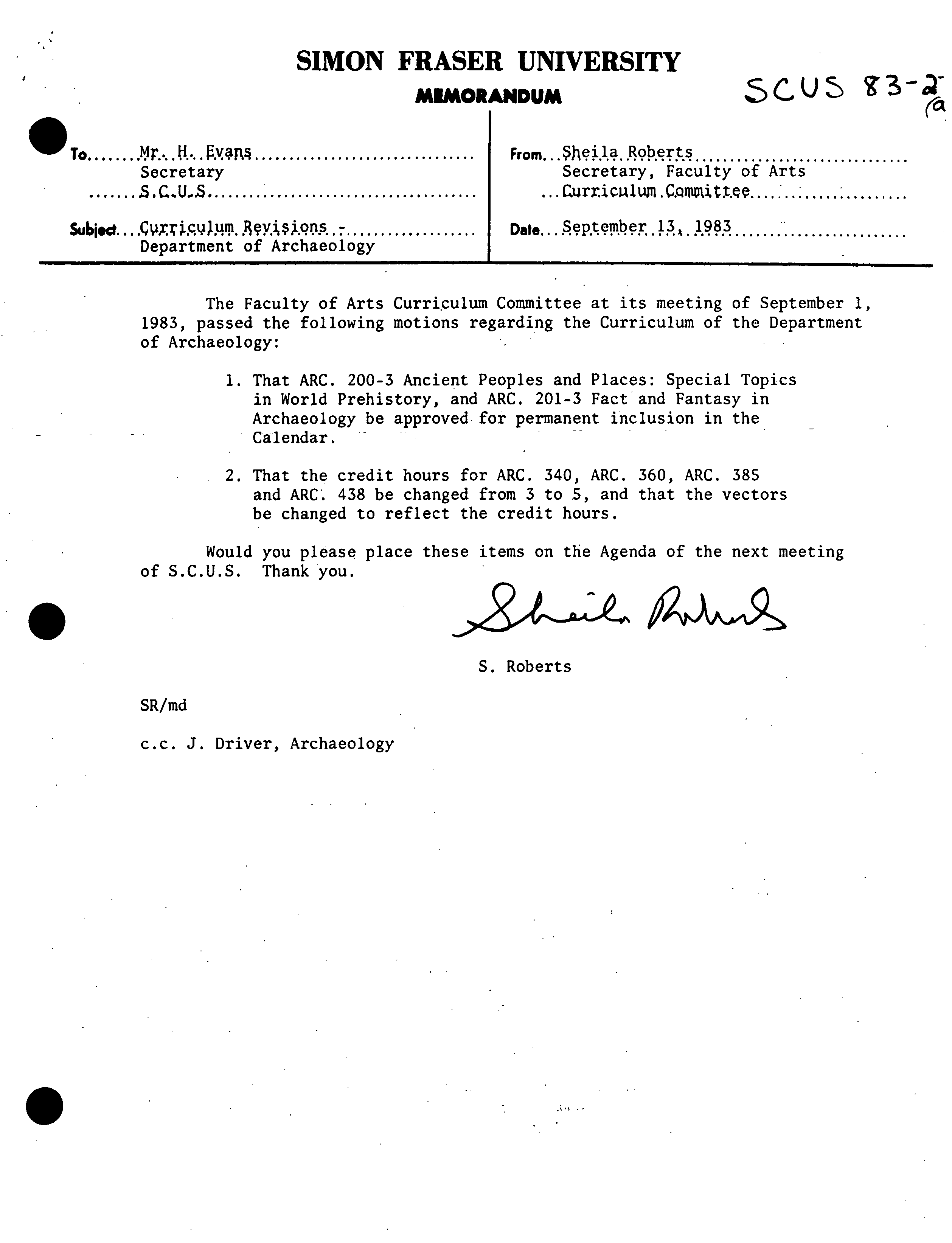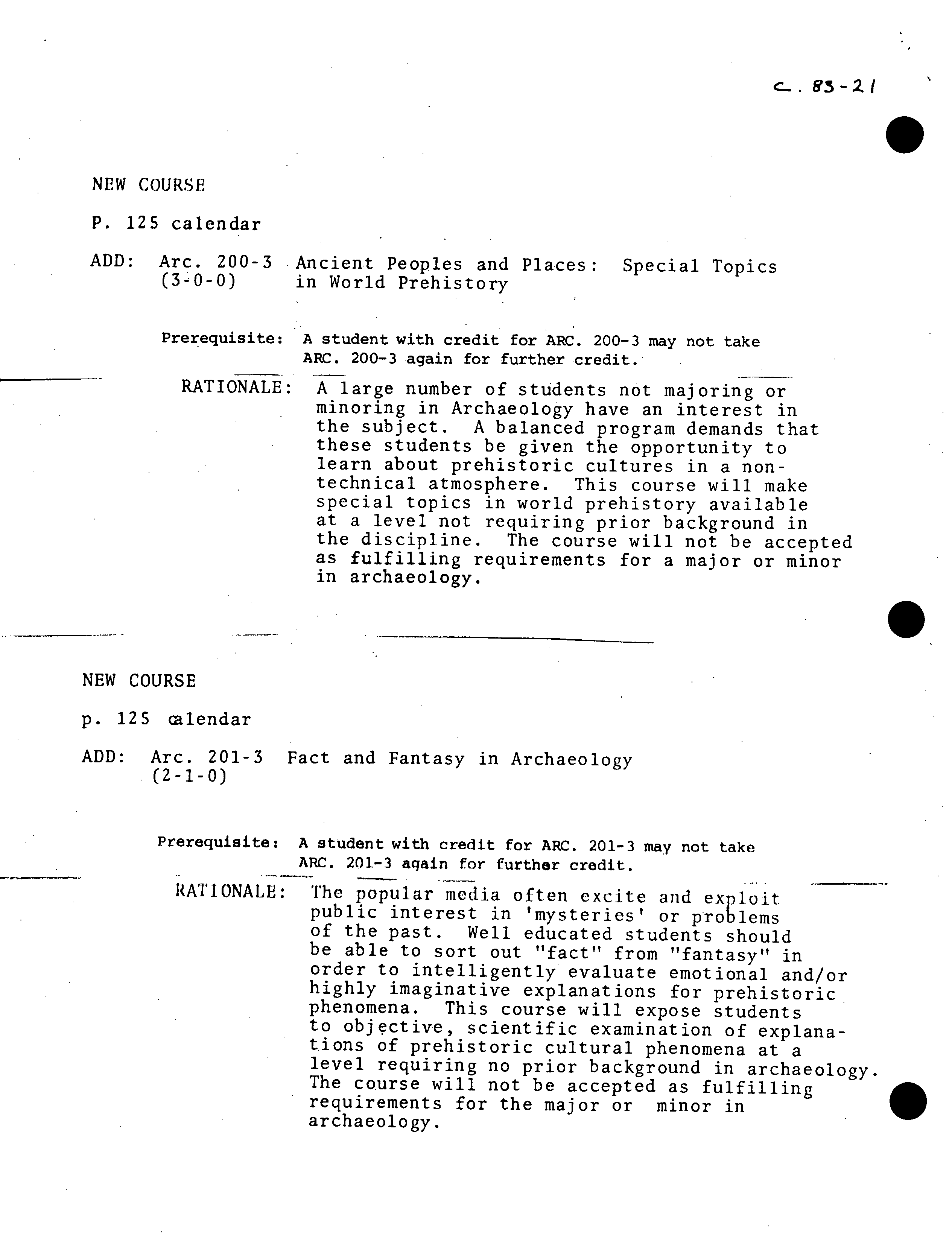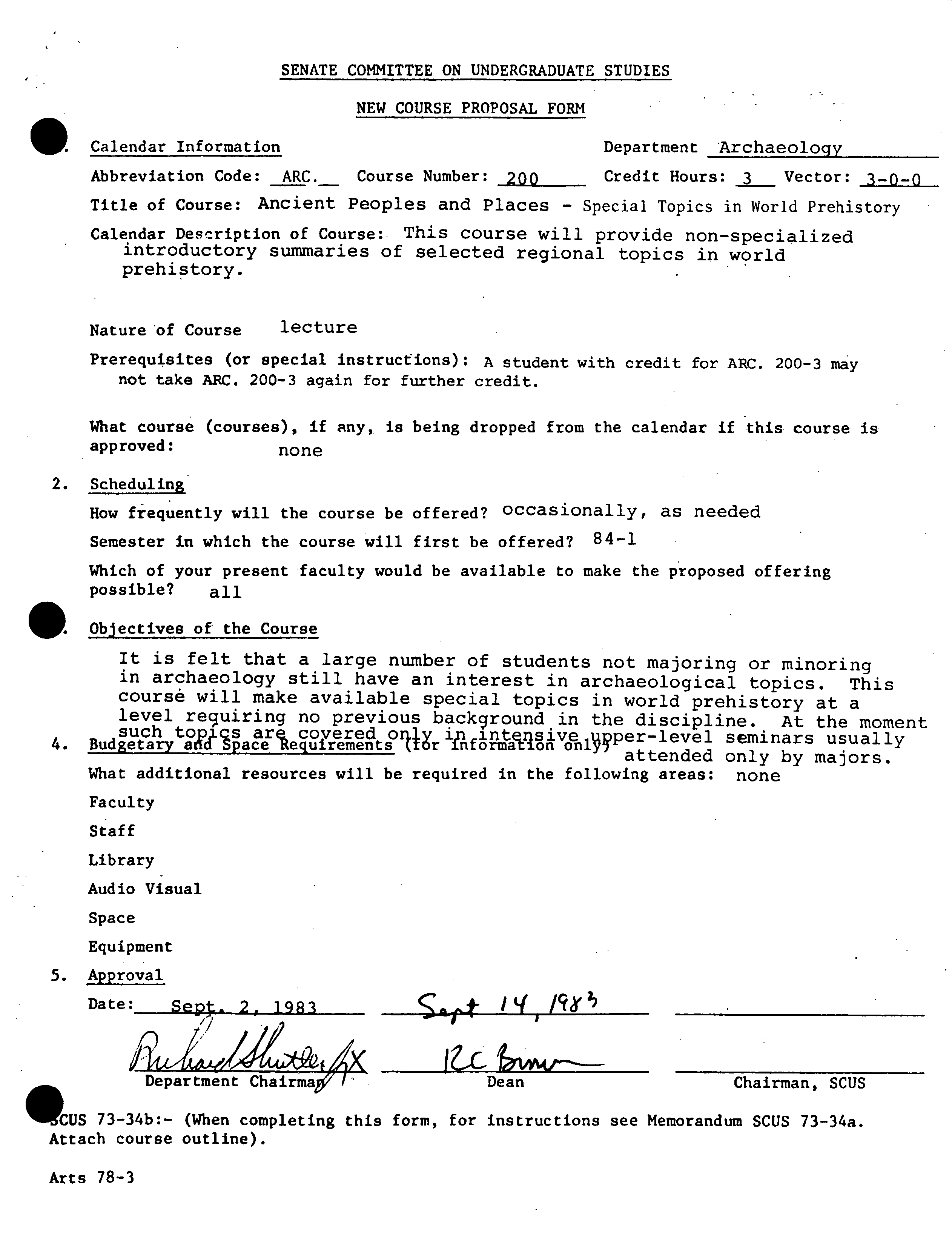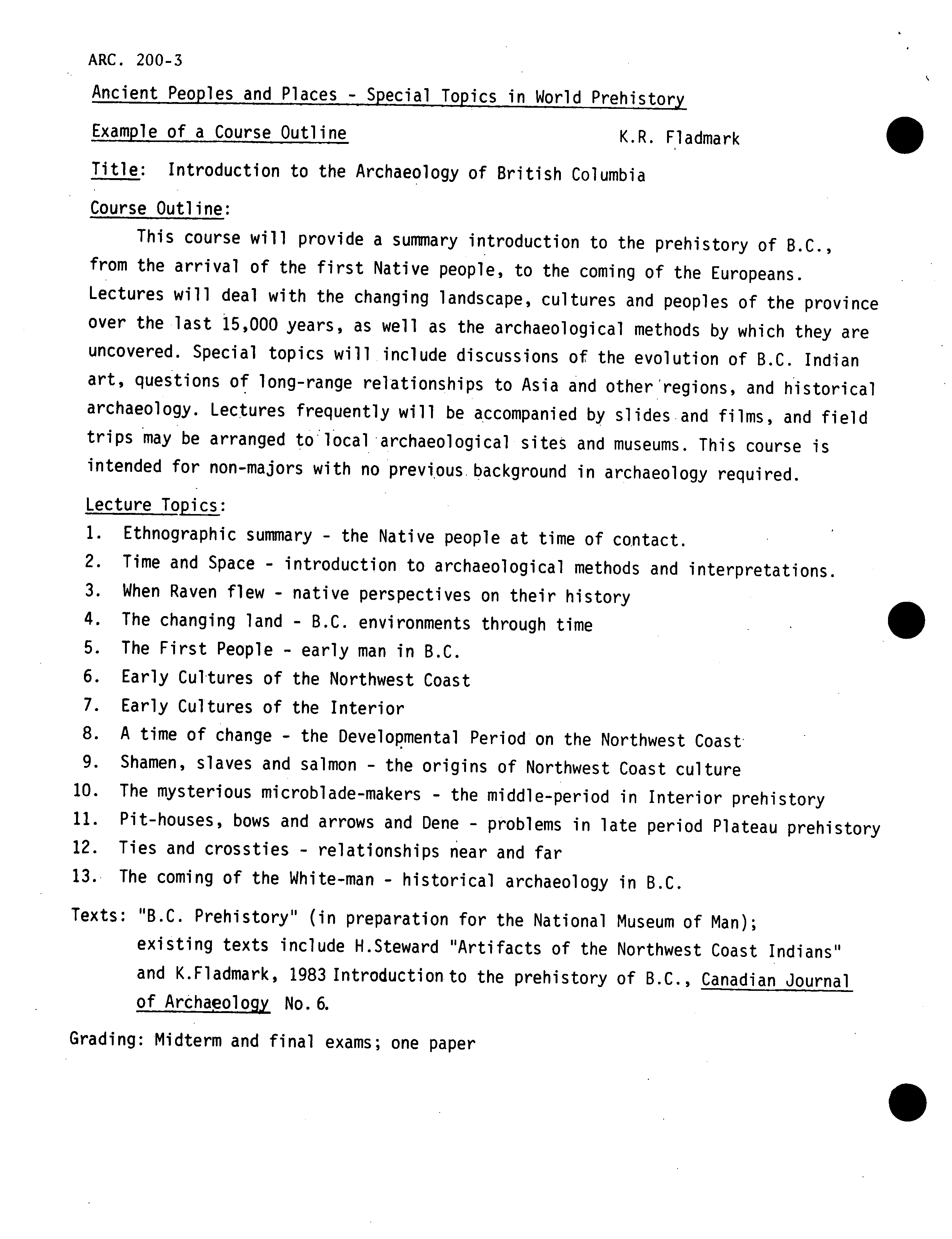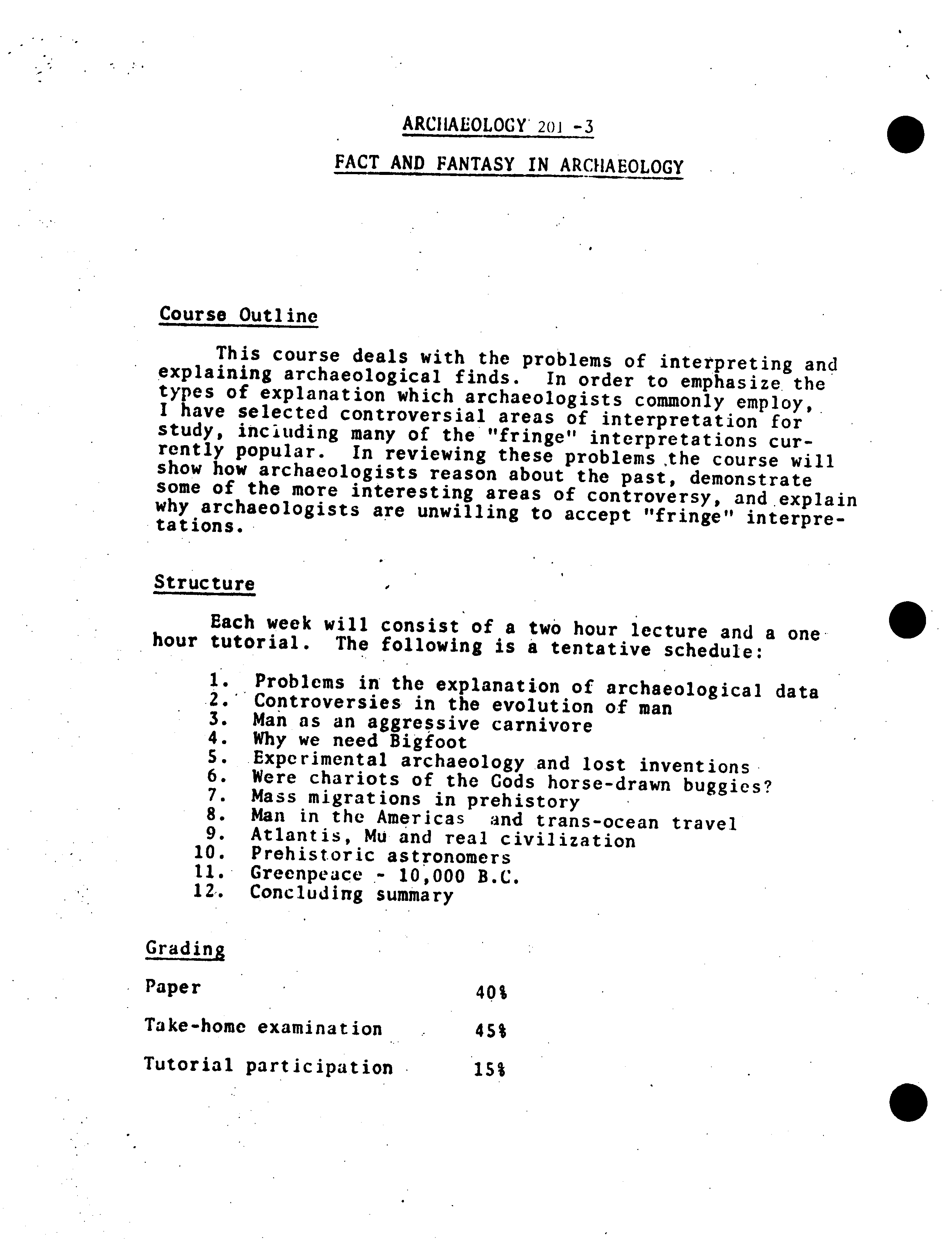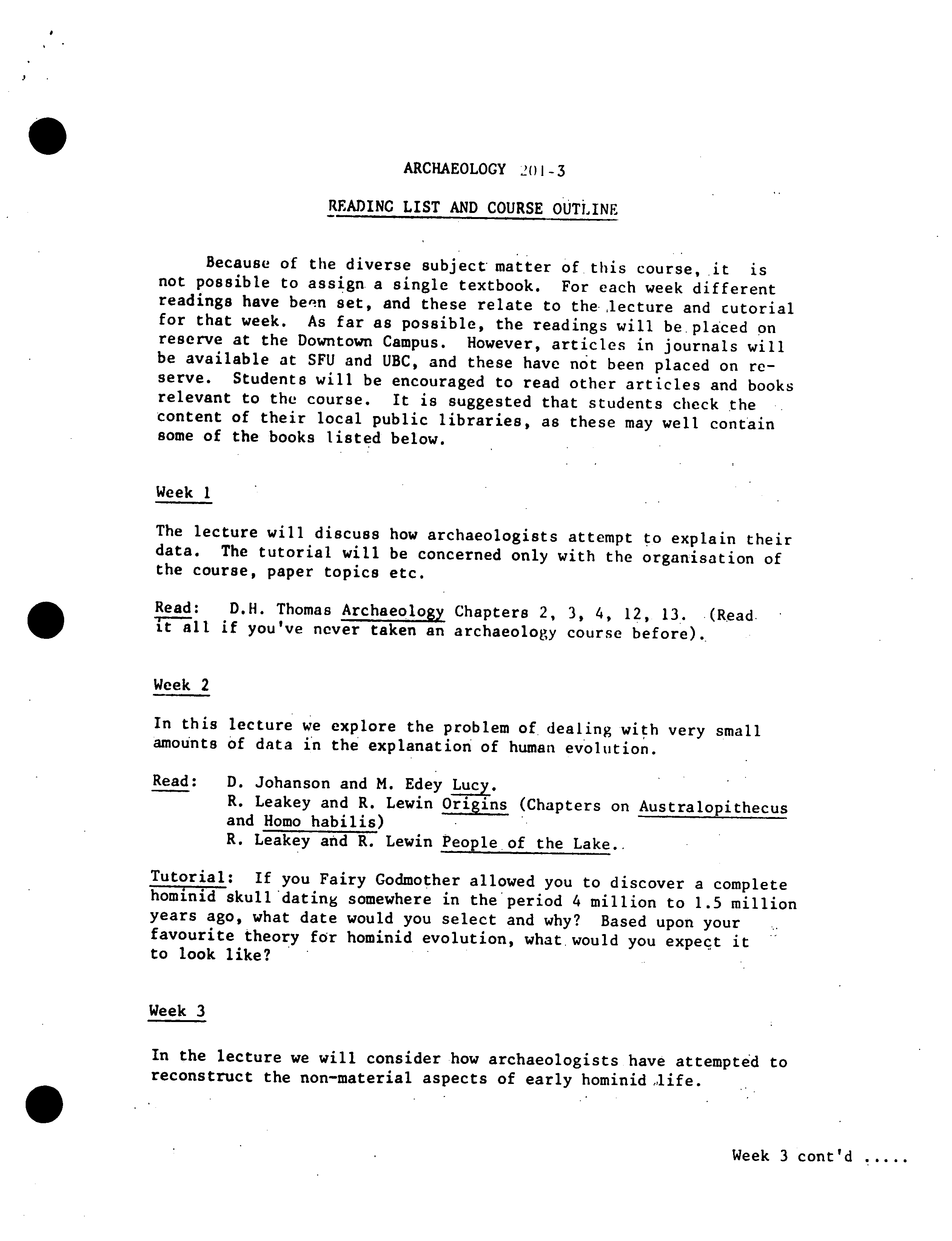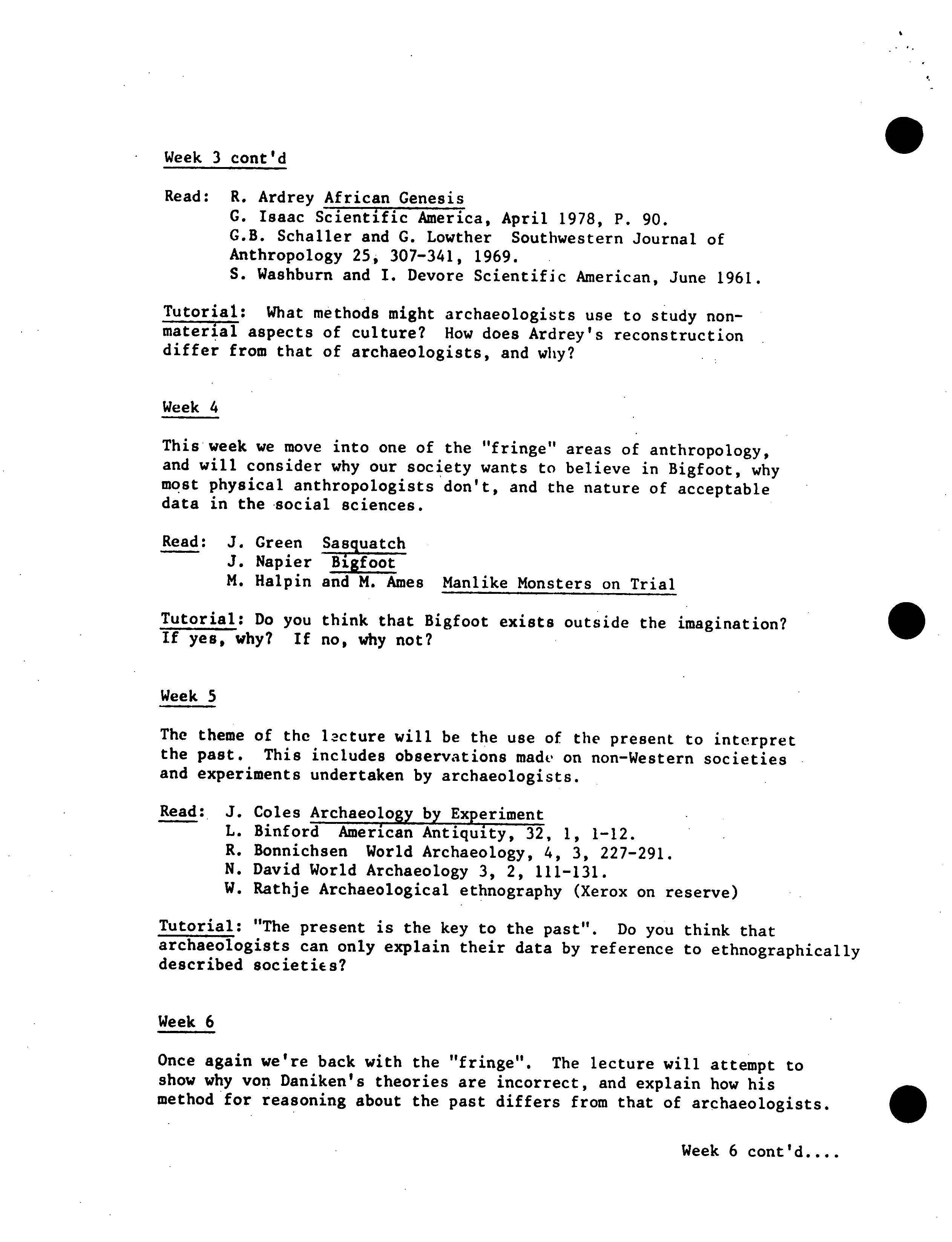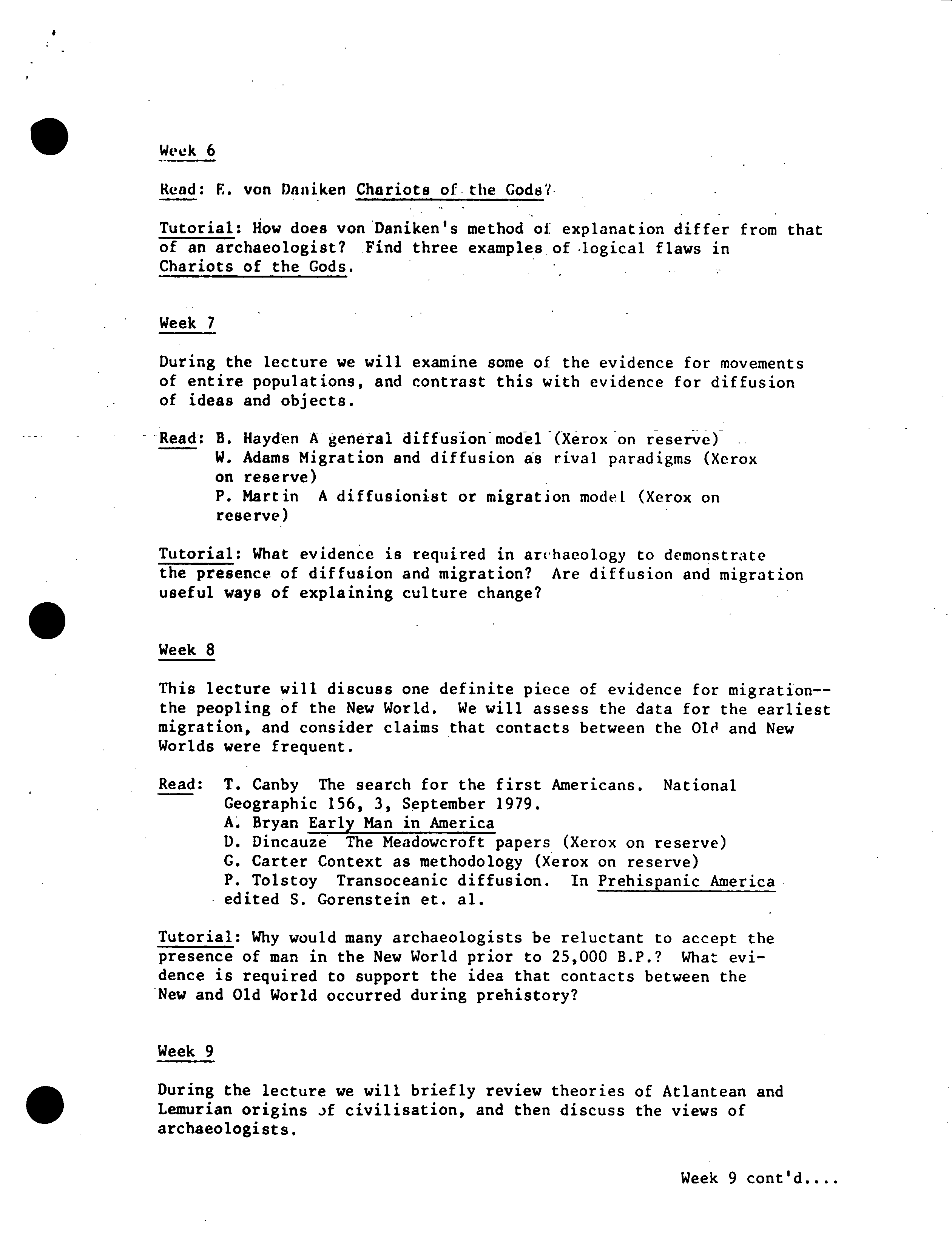so ........ SE
. NATE
From
..............................................
SEATE
N
COMMITTEE ON UNDERGRADUATE STUD
STUDIES
SiMON FRASER UNIVERSITY
MEMORANDUM
PROPOSED CHANGES - DEPARTMENT OF
.JJI1Iect .....
AiXEOOti'
.........................
Action undertaken by the Senate Committee on Undergraduate Studies
at its meeting of September 20, 1983 gives rise to the following motion:
MOTION:
"That Senate approve and recommend approval to
the Board of Governors, as set forth in S.83-68
the proposed new courses:-
ARC. 200-3 - Ancient Peoples and Places:
Special Topics in World Prehistory
A. 201-3 - Fact and Fantasy in Archaeology"
S
Subject to the approval of these courses by Senate and the Board of
Governors, the Senate Committee on Undergraduate Studies approved waiver of the
normal two semester time lag requirement in order that ARC. 200-3 may be first
offered in Spring 84-1.
FOR INFORMATION: Acting under delegated authority at its meeting of September 20,
1983, the Senate Committee on Undergraduate Studies approved
change in credit hours and vector for the following courses
from 3 to 5 credits and vectors from 3-0-0 to 5-0-0:
ARC. 360 - Indian Cultures of North America
ARC. 385 - Fossil Man
FOR INFORMATION:
Acting under delegated authority at its meeting of October 18, 1983
the Senate Committee on Undergraduate Studies approved the
proposed changes in vector and credit hours -
A. 340 - Introductory Zooarchaeology - change
S.
credit hours from 3 to 5; vector from
3-0-0 to 2-0-3
ARC. 438 - Geoarchaeology - change credit hours
from 3 to 5; vector from 3-0-0 to 3-0-2.
SiMON FRASER UNIVERSITY
MIMORANDUM
5CU
Secretary
s.c..u..s
.......................................
Subj.d
....
cv
i
'
i.
......................
Department of Archaeology
From. . .
.!'s...............................
Secretary, Faculty of Arts
UI'iCJUUJ11
.C.QrPUt&t.e. .......................
The Faculty of Arts Curriculum Committee at its meeting of September 1,
1983, passed the following motions regarding the Curriculum of the Department
of Archaeology:
1.
That ARC. 200-3 Ancient Peoples and Places: Special Topics
in World Prehistory, and ARC. 201-3 Fact and Fantasy in
Archaeology be approved
, for permanent inclusion in the
-
Calendar.
2.
That the credit hours for ARC. 340, ARC. 360, ARC. 385
and ARC. 438 be changed from 3 to .5, and that the vectors
be changed to reflect the credit hours.
Would you please place these items on the Agenda of the next meeting
of S.C.U.S. Thank you.
S. Roberts
SR/md
c.c. J. Driver, Archaeology
S
S
C_ .
&' 3-21
.
NEW COURSE
P. 125 calendar
ADD: Arc. 200-3 -Ancient Peoples and Places:
(3-0-0)
in World Prehistory
Special Topics
Prerequisite: A student with credit for ARC. 200-3 may not take
ARC. 200-3 again for further credit.
RATIONALE: A large number of students not majoring or
minoring in Archaeology have an interest in
the subject. A balanced program demands that
these students be given the opportunity to
learn about prehistoric cultures in a non-
technical atmosphere. This course will make
special topics in world prehistory available
at a level not requiring prior background in
the discipline. The course will not be accepted
as fulfilling requirements for a major or minor
in archaeology.
NEW COURSE
p. 125 calendar
ADD: Arc. 201-3 Fact and Fantasy in Archaeology
(2-1-0)
Prerequisite: A student with credit for ARC. 201-3 may not take
ARC. 201-3 again for further credit.
RATIONALE: The popular media often excite and exploit
public interest in 'mysteries' or problems
of the past. Well educated students should
be able to sort out "fact" from "fantasy" in
order to intelligently evaluate emotional and/or
highly imaginative explanations for prehistoric
phenomena. This course will expose students
to objective, scientific examination of explana-
tions of prehistoric cultural phenomena at a
level requiring no prior background in archaeology.
The course will not be accepted as fulfilling
requirements for the major or minor in
archaeology.
L
SENATE COMMITTEE ON UNDERGRADUATE STUDIES
NEW COURSE PROPOSAL
FORM
Department
Archaeology
Abbreviation Code: ARC. Course Number:
200
Credit Hours:
3
Vector:
3-0-0
Title of Course:
Ancient Peoples and Places -
Special Topics in World Prehistory
Calendar Description of Course:.
This course will provide non-specialized
introductory summaries of selected regional topics in world
prehistory.
Calendar Information
Nature of Course
lecture
Prerequisites (or special instructions): A student with credit for ARC. 200-3 may
not take ARC. .200-3 again for further credit.
What course (courses), if any, is being dropped from the calendar if this course is
approved:
none
2. Scheduling
How frequently will the course be offered?
Occasionally, as needed
Semester
in
which the course will first be offered? 84-1
Which of your present faculty would be available to make the proposed offering
possible?
all
Objectives of the Course
It is felt that a large number of students not majoring or minoring
in archaeology still have an interest in archaeological topics. This
course will make available special topics in world prehistory at a
level re9uiring no previous back9round in the discipline. At the moment
such to ;s ar covered o
seminars usually
4.
Budgetary add
?,pace eguirements
ormal. Ofl on
attended only by majors.
What additional resources will be required in the following areas:
none
Faculty
Staff
Library
Audio Visual
Space
Equipment
5.
Approval
Date:
Sept. 2, 1983
Department Chairmaf I .
Dean
Chairman, SE—
US
OCUS 73-34b:- (When completing this form, for instructions see Memorandum SCUS 73-34a.
Attach course outline).
Arts 78-3
ARC. 200-3
Ancient Peoples and Places -. Special Topics in World Prehistory
Example of a Course Outline
K.R. Fladmark
Title: Introduction to the Archaeology of British Columbia
Course Outline:
This course will provide a summary introduction to the prehistory of B.C.,
from the arrival of the first Native people, to the coming of the Europeans.
Lectures will deal with the changing landscape, cultures and peoples of the province
over the last 15,000 years, as well as the archaeological methods by which they are
uncovered. Special topics will include discussions of the evolution of B.C. Indian
art, questions of long-range relationships to Asia and other regions, and historical
archaeology. Lectures frequently will be accompanied by slides and films, and field
trips may be arranged tolocal archaeological sites and museums. This course is
intended for non-majors with no previous, background in archaeology required.
Lecture Topics:
I. Ethnographic summary - the Native people at time of contact.
2.
Time and Space - introduction to archaeological methods and interpretations.
3.
When Raven flew - native perspectives on their history
4.
The changing land - B.C. environments through time
5.
The First People - early man in B.C.
6.
Early Cultures of the Northwest Coast
7.
Early Cultures of the Interior
8.
A time of change - the Developmental Period on the Northwest Coast'
9.
Shamen, slaves and salmon - the origins of Northwest Coast culture
10.
The mysterious microblade-makers - the middle-period in Interior prehistory
11.
Pit-houses, bows and arrows and Dene - problems in late period Plateau prehistory
12.
Ties and crossties - relationships near and far
13.
The coming of the White-man - historical archaeology in B.C.
Texts: "B.C. Prehistory" (in preparation for the National Museum of Man);
existing texts include H.Steward "Artifacts of the Northwest Coast Indians"
and K.Fladmark, 1983 Introduction to the prehistory of B.C., Canadian Journal
of Archaeology No. 6.
Grading: Midterm and final exams; one paper
0
SENATE COMMITTEE ON UNDERGRADUATE STUDIES
NEW COURSE PROPOSAL FORM
Calendar Information
Department
Archaeology
Abbreviation Code: ARC.
Course Number:
201
- Credit Hours: 3
Vector: 2-1-0
Title of Course:
Fact and Fantasy in Archaeology
Calendar Deription of Course:
This course will provide non-specialized
introductions to selected problems of current and popular interest
in world prehistory and archaeology.
Nature of Course
lecture/tutorial
Prerequisites (or special instructions): A student with credit for
ARC. 201-3
may not take
ARC. 201-3
again for further credit.
What course (courses), if any, is being dropped from the-calendar if this course is
approved:
none
2.. Scheduling
How frequently will the course be offered?
occasionally, as needed
Semester in which the course will first be offered?
84-3
Which of your present faculty would be available to make the proposed offering
possible?
all
Objectives of the Course
Popular press and media often excite and exploit interest in mysteries
and problems of the past (e.g. Von Daniken, Atlantis, neocreationsirn,
etc.). This course will provide scientific and objective perspective
on such questions, at a level requiring no previous background in
archaeology.
4. Budgetary and Space Requirements (for information only)
What additional resources will be required in the following areas:
none
Faculty
Staff
Library
Audio Visual
Space
Equipment
5. Approval
Date:
Sept.
2, 1983
I'4J
kLAK
Department Chairma
Dean
*US 73-34b:- (When completing this form,
Attach course outline).
Arts 78-3
Chairman, SCUS
for instructions see Memorandum SCiJS 73-34a.
S
ARCHAEOLOGY'
201
-3
FACT AND FANTASY IN ARCHAEOLOGY
Course Outline
This course deals with the problems of interpreting and
explaining archaeological finds. In order to emphasize the
types of explanation which archaeologists commonly employ,
I have selected
controversial
areas of interpretation for
study, including
many of the "fringe" interpretations cur-
rently popular. In reviewing these problems the course will
show how
archaeologists reason about the past, demonstrate
some of the more
interesting
areas of controversy, and explain
why archaeologists
are unwilling to accept "fringe" interpre-
tations..
Structure
acn week will consist of a two hour lecture and a one
hour tutorial. The following is a
tentative schedule:
I. Problems in the explanation o
f
archaeological data
2. Contro
y
ersjes in the evolution of man
3.
Man as an aggressive carnivore
4.
Why we need Bigfoot
S. Experimental archaeology and lost inventions
6.
Were chariots of the Gods horse-drawn buggies?
7.
Mass migrations in prehistory
8.
Man in the Americas and trans-ocean travel
9.
Atlantis, Mu and real civilization
10.
Prehistoric astronomers
ii. Greenpeace .- 10,000 B.C.
U. Concluding summary
Grading
Paper
40%
Take-home examination
45%
Tutorial participation
15%
.
ARCHAEOLOGY 201-3
READING LIST AND COURSE OUTLINE
Because of the diverse subject matter of this course, it is
not possible to assign a single textbook. For each week different
readings have benn set, and these relate to the lecture and cutorial
for that week. As far as possible, the readings will be.pláced on
reserve at the Downtown Campus. However, articles in journals will
be available at SFU and UBC, and these have not been placed on re-
serve. Students will be encouraged to read other articles and books
relevant to the course. It is suggested that students check the
content of their local public libraries, as these may well contain
some of the books listed below.
Week 1
The lecture will discuss how archaeologists attempt to explain their
data. The tutorial will be concerned only with the organisation of
the course, paper topics etc.
•
Read:
D.H. Thomas Archaeology Chapters 2, 3, 4, 12, 13. (Read.
it all if you've never taken an archaeology course before).
Week 2
In this lecture we explore the problem of dealing with very small
amounts of data in the explanation of human evolution.
Read:
D. Johanson and M. Edey Lucy.
R. Leakey and R. Lewin Origins (Chapters on Australopithecus
and Homo habilis)
R. Leakey and R. Levin People of the Lake..
Tutorial: If you Fairy Godmother allowed you to discover a complete
hominid skull dating somewhere in the period 4 million to 1.5 million
years ago, what date would you select and why? Based upon your
favourite theory for hominid evolution, what, would you expect it
to look like?
Week 3
In the lecture we will consider how archaeologists have attempted to
reconstruct the non-material aspects of early hominid life.
...
.
.
Week 3 cont'd .....
Week 3 cont'd
Read: R. Ardrey African Genesis
C. Isaac Scientific America, April 1978, P. 90.
C.B. Schaller and C. Lowther Southwestern Journal of
Anthropology 25, 307-341, 1969.
S. Washburn and I. Devore Scientific American, June 1961.
Tutorial: What methods might archaeologists use to study non-
material aspects of culture? How does Ardrey's reconstruction
differ from that of archaeologists, and why?
Week 4
This week we move into one of the "fringe" areas of anthropology,
and will consider why our society wants to believe in Bigfoot, why
most physical anthropologists don't, and the nature of acceptable
data in the social sciences.
Read: J. Green Sasguatch
J. Napier !&!a 2t
M.
Halpin and M. Ames Manlike Monsters on Trial
Tutorial: Do you think that Bigfoot
exists
outside the imagination?
If yes, why? If no, why not?
Week 5
The theme of the lecture will be the use of the present to interpret
the past. This includes observations made on non-Western societies
and experiments undertaken by archaeologists.
Read: J. Coles Archaeology by Experiment
L. Binford American Antiquity, 32, 1, 1-12.
R. Bonnich g
en World Archaeology, 4, 3, 227-291.
N.
David World Archaeology 3, 2, 111-131.
W. Rathje Archaeological ethnography (Xerox on reserve)
Tutorial: "The present is the key to the past". Do you think that
archaeologists can only explain their data by reference to ethnographically
described societies?
Week
Once again we're back with the "fringe". The lecture will attempt to
show why von Daniken's theories are incorrect, and explain how his
method for reasoning about the past differs from that of archaeologists.
Week 6 cont'd....
.
Week 6
Rend: E. von Daniken Chariots of. the Gods?
Tutorial: How does von Daniken's method of explanation differ from that
of an archaeologist? Find three examples
.
of .logical flaws in
Chariots of the Gods.
Week 7
During the lecture we will examine some of the evidence for movements
of entire populations, and contrast this with evidence for diffusion
of ideas and objects.
Read: B. Hayden A general diffusion model (Xerox
-
on reserve)
W. Adams Migration and diffusion as rival paradigms (Xerox
on reserve)
P. Martin A diffusionist or migration modeL (Xerox on
reserve)
Tutorial: What evidence is required in archaeology to demonstrate
the presence of diffusion and migration? Are diffusion and migration
useful ways of explaining culture change?
Week 8
This lecture will discuss one definite piece of evidence for migration--
the peopling of the New World. We will assess the data for the earliest
migration, and consider claims that contacts between the Ole and New
Worlds were frequent.
Read: T. Canby The search for the first Americans. National
Geographic 156, 3, September 1979.
A Bryan Early Man in America
D. Dincauze The Meadowcroft papers (Xerox on reserve)
C. Carter Context as methodology (Xerox on reserve)
P. Tolstoy Transoceanic diffusion. In Prehispanic America
edited S. Gorenstein et. al.
Tutorial: Why would many archaeologists be reluctant to accept the
presence of man in the New World prior to 25,000 B.P.? What evi-
dence is required to support the idea that contacts between the
New and Old World occurred during prehistory?
Week 9
•
During the lecture we will briefly review theories of Atlantean and
Lemurian origins if civilisation, and then discuss the views of
archaeologists.
Week 9 cont'd....
Week 9 cont'd
Read: R. Wauchope Lost Tribes and Sunken Continents
K. Flannery The cultural evolution of civilisations
(article on reserve)
C. Redman The Rise of Civilisation (Chapters on the
developments of cities and civilisation)
Tutorial: Is the development of civilisation inevitable, once
certain conditions exist?
Week 10
During this lecture we will consider the problems of attempting to
discover whether early man used and understood astronomy.
Read: G. Hawkins Stoneienge Decoded
J. Eddy Science 184, 1035-1043, 1974.
J. Eddy National Geographic, 151, 1, 140-146, 1977.
C. Renfrew Social organisation in Neolithic Wessex.. (Xerox
on reserve)
Tutorial: Does the finding of astronomical alignments explain the
construction of certain classes of monuments?
is
Week 11
In the lecture we will consider the evidence for and explanations of
animal extinctions at the end of the Pleistocene.
Read: P. Martin and H. Wright Pleistocene Extinclons
Tutorial: Under what circumstances might a hunting society wipe out
its prey? If so many species became extinct at the end of the last
glaciation, why di the bison survive?
Week 12
Concluding lecture on explanation in archaeology.
Li
0


